
Rice has long been typecast as the “carb king.” It’s the first thing that gets slashed from low-carb diets, the villain in many weight-loss plans, and the silent filler in countless meals around the globe. But here’s a twist: rice does have protein. And not just a smidge — enough to matter, especially if you're tracking macros or eating plant-based.
So why do so many people believe rice is a protein wasteland?
Blame it on diet culture’s obsession with binaries. Carbs good, carbs bad. Protein strong, carbs weak. Rice? Just another white, fluffy filler with no muscle-building benefits… or so we've been told. But the truth is, that scoop of rice sitting on your plate is doing more nutritional heavy lifting than it gets credit for.
How much protein is actually in rice?
First off, yes — rice does contain protein, and the amount varies depending on the type. A cup of cooked white rice has around 4.3 grams of protein, while brown rice offers a bit more at roughly 5 grams per cup. If you’re looking for even higher protein content, wild rice delivers about 6.5 grams per cup, and black rice isn’t far behind with approximately 6 grams. While rice may not be considered a high-protein food, it still contributes meaningfully to your daily intake — especially when paired with other protein-rich foods.
That might not sound like a lot next to, say, chicken breast or lentils. But remember — rice is often eaten in generous servings and usually paired with beans, dal, tofu, or meat. Together, these foods can form a complete protein profile, especially in vegetarian and vegan diets.
Also worth noting:
rice contains all nine essential amino acids — though not in the ideal ratio to be considered a “complete protein” on its own, it’s still a valuable contributor when combined with other foods.
The myth of “just carbs”
Somewhere along the fitness timeline, carbs got a bad rap, and rice became collateral damage. While yes, rice is primarily a source of carbohydrates, that doesn’t cancel out its protein content.
In fact, entire populations — from Japan to India to parts of Latin America — have traditionally relied on rice-based meals as primary fuel. And these aren’t protein-deficient communities. That’s because they balance their rice with lentils, vegetables, eggs, meat, or seafood — a natural combo that delivers nutrition in full.
Rice and muscle building
Bodybuilders and gym-goers, listen up: Rice can absolutely be part of your protein-friendly diet. In fact, professional athletes often include white rice in their meal prep. Why? It’s easy to digest, pairs well with protein-rich foods, and helps restore glycogen levels post-workout.
And here’s the kicker — rice protein is actually a thing in the supplement world. Rice protein powders (especially brown rice-based) are marketed as hypoallergenic, plant-based protein sources for those avoiding dairy or soy. According to a 2013
study published in Nutrition Journal, rice protein was just as effective as whey in building muscle when paired with resistance training.
So no, rice doesn’t deserve that “all carbs, no gains” slander.
Brown rice vs white rice: Is one better?
Here’s where things get slightly nuanced. Brown rice has a bit more protein, fiber, and nutrients because it still has the bran and germ layers intact. It digests more slowly, keeps you full longer, and has a nuttier taste.
White rice, on the other hand, is milled and polished — stripping away some nutrients in the process. But it’s still not “bad.” In fact, it’s gentler on sensitive stomachs, quick to cook, and less likely to contain arsenic (a concern in some brown rice varieties if overconsumed).
Combining rice with other protein sources
This is where rice really shows off. It may not be the protein superstar on its own, but when you team it up with the right partners, magic happens. Think dal chawal — that humble South Asian classic is actually a complete protein. Or rice and beans, the go-to combo across Latin America, both tasty and nutritionally solid. Mix rice with tofu or tempeh, and you've got a plant-based power plate. Add eggs or chicken, and it’s a gym bro’s dream meal. Even something like fish curry with rice is a perfect balance of omega-3s and carbs. In all these pairings, rice isn't just a sidekick — it’s doing some real heavy lifting, fueling your body and rounding out the nutrition beautifully.
Rice is not the villain
It’s not protein-free. It’s not “just carbs.” It’s one of the most versatile, comforting, and yes — nutritious — grains on the planet. While it won’t replace your lentils or eggs in the protein department, it contributes meaningfully to your total intake, especially when eaten in balance with other foods.
So next time someone tells you that rice has no protein, hand them a spoon and say, “Here — have a bite of facts.”
